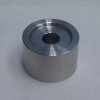I bought 1000 pieces of .223 brass that the seller advertised as "prepped." That meant it was cleaned, swaged, sized, and trimmed. The price was too good to pass up. (This wasn't Scharch, which is my go-to rifle brass seller.)
When it arrived, I measured the length--perfect. Then I checked the neck width and tension--also perfect. Chamfer, deburr, and good to go, right?
I loaded up 400 rounds a few days ago. Everything went smooth, from priming to seating, so I put them in some bags and stashed them away. (Can anyone see yet what I failed to do?)
Yesterday, I decided to load a magazine of the stuff into my (totally reliable) AR. Hmm. The first round chambered roughly. I cycled it through, and the second round jammed the whole thing up like it was made of glue. Just from the feel of it, I suspected the problem--so I did what I should've done in the first place, and I dropped the round into my case gauge. The shoulders needed to be bumped back a few thousandths. :|
Lesson learned: Almost no ready-to-load brass is really ready to load. Check everything.
When it arrived, I measured the length--perfect. Then I checked the neck width and tension--also perfect. Chamfer, deburr, and good to go, right?
I loaded up 400 rounds a few days ago. Everything went smooth, from priming to seating, so I put them in some bags and stashed them away. (Can anyone see yet what I failed to do?)
Yesterday, I decided to load a magazine of the stuff into my (totally reliable) AR. Hmm. The first round chambered roughly. I cycled it through, and the second round jammed the whole thing up like it was made of glue. Just from the feel of it, I suspected the problem--so I did what I should've done in the first place, and I dropped the round into my case gauge. The shoulders needed to be bumped back a few thousandths. :|
Lesson learned: Almost no ready-to-load brass is really ready to load. Check everything.



